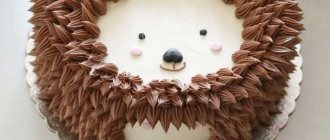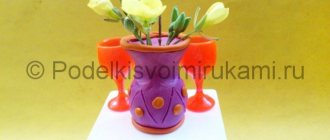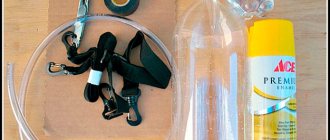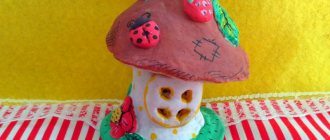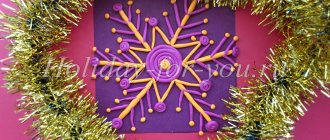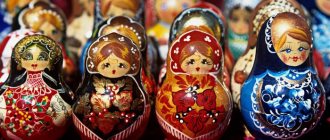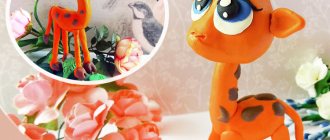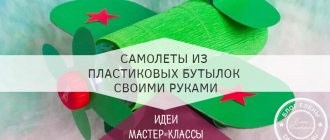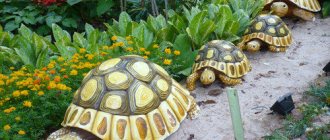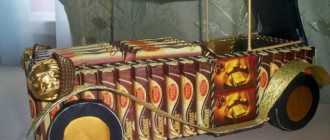Greetings, dear friends!
And we all continue to make crafts with the kids and share new ideas with you! I hope our activities inspire you and that you also engage with your kids! Well, today we will tell and show you how to make a kolobok craft with your own hands for kindergarten. Of course, we didn’t stop there, and in the evening, when my son came home from kindergarten, we arranged a continuation of our activities, so it turned out to be a themed lesson on the “Kolobok” theme, and not just an easy craft, as originally planned. But first things first. By the way, we recently did a themed lesson on the fairy tale Turnip, if you haven’t seen it, I advise you to look here. Let’s start making our own kolobok crafts with our own hands.
From a ball and twine
How to make a Kolobok from twine? Such a craft turns out to be original and creative. It doesn’t look much like Kolobok from a fairy tale, but it emphasizes the style and fits well into the country house ensemble, consisting of original wire parts. It is possible to supplement it with internal lighting and make it an element of decorative lighting.
The following master class will help with this:
- A regular round balloon is inflated. You should not set a goal to inflate as much as possible, otherwise further work will be difficult (Fig. 8). The thread connecting the inflatable hole is left short - it has no further significance.
- The end of the selected string is attached with tape to the flat surface of the ball (Fig. 9).
- The entire surface is smeared with glue, and twine, also treated with glue, is quickly wound around it (Fig. 10). Winding must be done evenly in all directions, trying to cover the coated surface as much as possible. The more string you attach, the tighter the bun will be. For more dense gluing, you can additionally apply glue to the already applied layer and, without waiting for final drying, work further.
- After the structure has dried, the rubber ball bursts by piercing (Fig. 11) and is pulled out through a specially made hole (Fig. 12).
The Kolobok layout is ready. Let's start decorating it. We make a cap, beret, bows or a hat from colored paper, fabric, cardboard or foam plastic (Fig. 13). We fasten with glue, preferably in several places.
INTERESTING: Summer-themed crafts with children
We design his face, especially focusing on his kind features and expressive eyes (Fig. 14). And Kolobok, made from scrap materials, is ready to decorate any area. The twine can be any color, but a yellow tint will be more realistic, because this is exactly what a creation from dough can be.
Master class on making the fairy tale “Kolobok” from paper rolls
Galina Nakonechnaya
Master class on making the fairy tale “Kolobok” from paper rolls Hello, Dear Colleagues!
I bring to your attention the fairy tale “
Kolobok ” , made from
paper rolls .
To make fairy tale heroes , we will need:
— bushings , according to the number of fairy tale ;
- a set of colored paper ;
We measure the sleeve in height , cut off a strip of paper of the desired color , in this case (white, for a bunny, and paste it over the sleeve . Then select the bunny's face you like, cut it out and glue it in the upper part of the sleeve , only in the center, leaving the edges of the muzzle not glued. Cut it out. two front legs and a tail, outline it with a marker and glue it in. Our bunny is ready!
In exactly the same way, we make the figures of other animals: a wolf, a bear and a fox.
Trees can also be made using this principle: cover the bushings with brown paper , and cut out the tree crown from green cardboard.
We print out the figures of Grandfather, Grandmother and Kolobok , color them, cut them out; We cover the sleeves with colored paper and glue the figures onto them, not forgetting to leave the edges of the face unglued.
For the house, take a piece of cardboard of a suitable size, bend it in half, and glue a picture of the house.
You can do these crafts together with your children, believe me, the children will be very happy, and the time spent together will benefit everyone, and then you can arrange to watch a fairy tale .
Thank you for your attention!
I will be glad to see your feedback!
"Parrot". Master class on making toys from paper circles Hello, guests of my page! Today I would like to present to your attention a master class on making toys from paper circles. "One two three four five! The bunny came out for a walk!” master class on crafts made from paper rolls Let me introduce you to a master class on crafts made from paper rolls. We decided to make these bunnies with our children on March 8th for our mothers. Master class for children of the middle-high group “Drawing based on the fairy tale Kolobok” Objectives: teach children to draw a plot from the fairy tale Kolobok; improve brush and gouache technique; learn to use decorative elements. Master class on making Christmas trees from toilet paper rolls. New Year is coming. It is impossible to imagine him without Santa Claus, without snow and snowflakes, and most importantly without the Christmas tree! Making such a Christmas tree. Master class on making lilies from paper napkins, dear colleagues, good day! To everyone who has looked at my page, I would like to offer a master class on how to make such a lily. Master class on making a gift from paper lumps for February 23rd. On the eve of the holiday, we often think about an interesting and unusual gift. This year we were given the idea of making a gift for dads. Master class on making the Snow Maiden from paper napkins with Grandfather Frost. I live in the wilderness of the forest, Behind the distant birch tree, Our house is icy. All forest animals have been my friends for a long time. Dear Snow Maiden. Master class on making a cap for the fairy tale “Kolobok” using the papier-mâché technique Hello, today I would like to share with you the idea of creating a character’s cap for theatrical activities in kindergarten.
Source
From papier-mâché
An interesting and unusual option for making a kolobok from papier-mâché (Fig. 6). The technique used here is to paste a round object with a mixture of moistened crushed egg trays and PVA glue. Applying such a layer will give the sculpture volume, heterogeneity, and visual naturalness. After the mold has dried, water-based paint, preferably white, is applied to it. As it dries, they begin to paint the Kolobok model with yellow paint (the final version).
To make facial features voluminous, the paper mixture is glued in a thicker layer at their locations. After complete drying with a knife, you can more expressively cut out dents and protrusions, fix the relief of the eyes, mouth (of course, in a smile), nose, and ears.
You can make a scarf or beret from the same material. Coloring will not be difficult.
In order for a figurine made of such material to be practical and stand intact until the end of the summer season, before painting it can be coated again with glue, drying oil or other composition to strengthen the structure during street work.
A DIY papier-mâché bun at the dacha looks original and interesting. Moreover, you can decorate it to your liking. Additional parts are made from:
- fabrics;
- wires;
- foam rubber;
- wood and other materials.
Simple ideas
The simplest option is to paint any round object and put eyes, nose, and a smile on it. Figures 1-3 show just such models. In this case, the figurine can be supplemented with design elements: a scarf, a cap, arms and legs, curls of hair, a basket (Fig. 4, 5).
For such work, paints should be used that are intended for outdoor use, since a hero installed outdoors is susceptible to precipitation, wind, and other negative environmental factors.
Such figures can be arranged in different ways, for example, strengthening the Kolobok on a stump - fig. 7. This is convenient for playing and will protect the product from becoming limp in puddles of rain.
From polyurethane foam
Another interesting way is to make a Kolobok from polyurethane foam, using a ball:
- We cover it with foam in several layers, allowing them to dry one by one (Fig. 15). We apply more foam to protruding areas (nose, mouth, etc.).
- For the arms and legs we prepare tubes, which we also treat with foam (Fig. 16).
- We paint the entire work yellow and highlight the facial features (Fig. 17).
Making a kolobok for a summer house with your own hands from plaster is similar (Fig. 18-22). Working on it for the garden with our own hands, we give the figurine a piece of our soul, we try to make it kind and cheerful, as well as recognizable. We often surround ourselves with vegetation, heroes of the same or other fairy tales.
How to make a bun from paper and cardboard
Do-it-yourself crafts of fairy tale heroes from colored paper and cardboard are made for different purposes and in different ways. But most of them are simple enough for a child to make a paper bun on their own.
Origami with diagrams
All the heroes of the fairy tale Kolobok can be made in the form of origami. To do this, you just need to follow the addition diagram.
Kolobok
You can make a kolobok in the form of a hexagon rather than a regular circle.
The resulting hexagon can only be added with eyes, a nose and a mouth to complete the craft.
Grandmother and grandfather
It is also possible to make a little man using the origami technique. Although it is already more difficult than a kolobok.
Hare, wolf, bear, fox
Other fairy tale characters for children are also performed using the same technique.
Source
Volumetric craft using modular origami technique
Modular origami looks very impressive. But assembling them is quite labor-intensive, since each such craft consists of many small parts that are inserted into each other. It is very difficult to read the description and follow it; it is easier to do such work by looking at an example.
The main part of the work is the assembly of parts - modules. Their appearance may vary. They can also be purchased ready-made, avoiding the most lengthy process. However, according to experts, it is this kind of work that has a calming effect on children and helps develop concentration and perseverance.
Will be useful: Modular origami for beginners.
Features of paper crafts for the fairy tale “Kolobok”
Paper crafts for the fairy tale Kolobok can be of different types:
- in the form of an application;
- in the form of paper dolls for puppet theater;
- in the form of children's masks for playing in skits;
- three-dimensional figures for plot installation, etc.
Depending on the purpose, the type of craft changes. Each of them is worth special attention.
Examples of paper characters from fairy tales
First of all, you need to remember who the main characters were in the fairy tale Kolobok. First of all, this is Kolobok himself. These are also his grandparents, thanks to whom he was “born.” And after that - all the animals he met in the forest - a hare, a wolf, a bear and a fox.
Paper bun
A paper bun can be in the form of an applique.
In the form of three-dimensional figures.
Kolobok head mask made of paper for theatrical scenes.
Or three-dimensional figures for acting out a fairy tale or modeling a plot.
Paper crafts of other heroes
You can make the rest of the heroes using the same principle as the kolobok. Moreover, most often they are performed in the same style.
DIY crafts made from natural materials
Volumetric compositions and applications can be made from natural ingredients: dry leaves, cones, grass. You can make an old forest man from a pine cone and dry twigs:
- Take two cones, one longer, it will indicate the character’s torso, the other small, more rounded one will represent the head.
- The cones are glued to each other, small on top, extended underneath with the narrow side down.
- From the bottom to the long cone, two small branches are glued with PVA glue - the legs of the forest tree. They are “shoeed” with bast shoes made of brown plasticine. And eyes are glued to the top round cone; you can buy them at a sewing store or make them yourself from plasticine.
- The next step will be the forest tree’s hat, it can be made from a dry leaf of a tree or from birch bark, it needs to be folded into a cone and attached to the top of the cone.
- The old man's mouth is sculpted from a thin strand of plasticine.
- The woodsman’s hands are like tree branches, proportioned to the right size. In one of the “hands” you need to glue another branch as tall as the character. This is the staff of a magical forest dweller.
The unusual character is ready.
From dry leaves and twigs you can continue the composition and create a surrounding forest. This craft can be taken to a kindergarten competition dedicated to fairy tales; it will delight children and teachers.
Application “The Fox and the Gingerbread Man”
The famous cunning Fox and Kolobok, who left his grandfather and grandmother, can be personified on a flat surface. Doing this type of creativity with your child develops their imagination very well.
For production you need cardboard, paper, paints, brushes, glue. To make drawing easier, you can take a ready-made picture of a fox and a bun and transfer the outlines through a transfer onto cardboard.
And you can also paint the background in the picture in advance, so as not to stain the characters with paint later. After the background has dried, you can glue wheat groats along the silhouettes of the characters. The world around the Fox and Kolobok can also be made three-dimensional, for example, trees and grass can be covered with grain.
After everything is ready and dry well, you can start painting. This must be done carefully so as not to touch unnecessary elements. After the paint has dried, the work is ready! Can be framed and hung on the wall.
Thus, we can come to the conclusion that, using various materials, imagination, ready-made pictures that you can focus on, you can create your favorite character from any fairy tale.
The child will be happy, the children's room will be filled with cozy and unusual compositions that will surprise your guests. It is very useful for children to engage in this type of activity, as they develop imagination, logic and hand motor skills.
You can experiment with different materials, complement them according to the logic of creating certain compositions, bring in something new and unusual, perhaps the child himself will suggest new ways.
You need to listen to your child, because children do not have a blurred view of things, like adults, and they can quickly find new approaches to solving a particular problem.
Russian fairy tales are distinguished by their unusual characters, they teach kindness, helping each other, not being greedy, not being afraid to go on adventures, and, of course, that good triumphs over evil.
Chicken Ryaba
The finger theater for the embodiment of the theatrical fairy tale “Ryaba Hen” includes: a village hut (from the inside), grandmother, grandfather, chicken, mouse and egg.
To create characters, you should stock up on consumables:
golden egg
To make a golden egg, you need to cut out 2 parts of an oval from yellow felt and sew them together, filling them with padding polyester.
There is no hole left for your finger in this toy.
Hut
To sew a beautiful hut as a decoration for the fairy tale “Ryaba Hen”, you will need:
Hut assembly:
An original and beautiful version of the kolobok
You can construct a bun with your own hands from a balloon, glue and thread.
The stages are as follows:
We inflate a round ball, coat it on all sides with glue and wrap threads on top of the glue: the more threads, the more real the hero will turn out.
After the threads have dried, glue the mouth, eyes, and nose onto the intended face. On the top of the head there is hair made of threads. The hero is ready - the performance will take place.
A variation of this type of work can be called a pasta kolobok, when instead of threads on glue we “plant” pasta of a suitable shape, for example, as in Fig. 9.
INTERESTING: Playing theater: Cinderella
How to do:
- Let's prepare a house-base for a fairy tale. To do this, take a sheet of blue paper and bend it on both sides, as shown in the photo. Bend the upper corners on both sides so that you get the shape of a house. Trim the folded corners. Cut out two small rectangles from white paper and write the name of the fairy tale on them.
- Decorate the outside of the house. Cut out windows from yellow paper. Use a felt-tip pen to draw frames on the windows. Draw patterns on the roof. Cut out two bushes from green paper. Draw and cut out the flowers. Glue green bushes under the windows of the house, and flowers on them.
- Now expand the fairy house. Let's make a house for grandparents and a forest inside. First, cut out the grass from green paper and glue it to the left side of the fairytale decoration. Fold a small rectangle of brown paper in half and cut out the shape of a house as shown in the photo. Glue the house onto the grass so that it can open.
- Uncover the grandparents' house. Draw a stove inside. Glue the table from colored paper, gluing only the side legs. Then you can “seat” your grandfather or grandmother at the table. You can decorate the house the way you want. We completed the clock and the shelf with dishes. Close the house and stick the windows and door on it.
- Now we need to make a forest for the bun to run through. Cut out bushes, grass, and Christmas trees from green paper of different shades.
- Glue the grass and bushes without applying glue to the top of these parts. This way you can put fairy tale characters in the grass and behind bushes like in pockets. Glue Christmas trees and trees, you can draw them. Cut out clouds from white paper and glue them to the sky. Cut out and glue a sun from yellow paper.
- The scenery is ready. It's time to start making fairy-tale characters. You can draw them and cut them out, that’s what we did. You can print out the necessary pictures from the Internet or cut them out from old children's magazines. This is how we turned out to be the main character of the fairy tale - Kolobok.
- Look how we drew grandpa.
- And this is what our grandmother turned out to be like.
- When Kolobok ran away from his grandparents, the first thing he met was a bunny. This is the bunny we drew and cut out.
- Then Kolobok met the wolf, sang a song to him and rolled on. Look what a wolf we got.
- After the wolf, Kolobok met a bear. Here's how to draw it.
- And of course, the cunning fox, who in the fairy tale deceived Kolobok and ate him. This is how we drew the fox.
Craft ideas based on children's fairy tales
There are a huge number of ideas for creations on fairy-tale themes; you can depict individual characters, as well as entire scenes. Crafts can be either flat in the form of paintings or three-dimensional with small sculptures.
Plasticine Alyonushka and little brother goat
Based on the fairy tale “Sister Alyonushka and Brother Ivanushka,” where the main characters were the girl Alyonushka and her brother, who turned into a kid, you can make a composition from plasticine.
To create a picture you need to take colored cardboard of blue or cyan color, indicating the sky:
- Prepare in advance an image of Alyonushka and Ivanushka, turned into a kid, so that you can visually see the picture.
- To make panels, take plasticine of different colors or salt dough. If you take the dough, then prepare more paints and brushes in advance.
- Looking at the picture, you sculpt the figures of the characters.
If you are making a craft from colored plasticine, then the colors are selected in accordance with the picture.
If you decide to sculpt figures from salt dough, you need to make the material itself. To do this, take flour, salt and cold water. Water 200 ml, flour 300 ml, salt 300 gr.
If you plan to make a very small product, then you can take fewer ingredients, the main thing is to maintain the proportions, the same amount of flour and salt, and less water. The dough should have the consistency of plasticine.
Rocker with buckets made from popsicle sticks
Based on the famous fairy tale “Emelya and Pike,” you can create an interesting composition with wooden ice cream sticks, depicting a rocker and buckets:
- You need to make two small tubes, glue thick cardboard so that you get a small roller. Cover them in a circle with ice cream sticks on top.
- Cut narrow strips from pieces of leather or thick brown fabric and tie them around the bucket in two places, top and bottom.
- Next, you need to make a rocker from a piece of leather cut in a semicircle.
- Wrap the leather with wire and secure the edges of the wire to the edges of the buckets so that the composition looks holistic.
- You can make “legs” underneath the buckets - attach a wire tightly wrapped in a spiral, and you can wrap a rope around it on top for greater aesthetics. And at the bottom, fashion bast shoes from brown plasticine or colored salt dough.
Paper bun applique
You can make a simple applique out of colored paper even with the youngest children. To do this, you need to stock up on paper glue, colored paper, cardboard, brushes and scissors with rounded edges if you are doing this with a child:
- You can take a picture from the fairy tale Kolobok for help and try to reproduce this picture from colored paper.
- Cut out the bun itself in a circle from yellow paper and create surrounding objects - a Christmas tree or a tree, a green background that will represent the grass and the house from where the bun escaped.
- Initially, you can take blue cardboard so as not to cut out the sky background separately.
- Glue everything with paper glue. It is better to spread the glue with a brush so that there are no unevenness on the application. It will be interesting for the child to do this work, because he will see how a whole picture comes to life from ordinary pieces of paper.
Pasta bun
A three-dimensional Kolobok figurine can be made from a food product - pasta. No matter how unusual it may sound, you can make a lot of different products from pasta, not only edible ones:
- To make a Kolobok, you need to inflate a medium-sized balloon to make it easier to create a ball shape.
- Next, it’s a matter of technique, you need to take pasta, preferably in the form of stars or flowers, and good quality glue that can glue such products together - PVA glue or superglue.
- Then the pasta is glued together in the shape of a ball until it forms a hemisphere.
- When the Kolobok is almost ready, you will need to burst the ball and pull it out until the entire space is sealed.
- Next you need to add the ball shape. You can glue eyes, a nose and a mouth cut out of colored paper to the finished bun.
- This work can decorate your kitchen or child’s nursery.
Craft “Frog Princess” made from salt dough and colored paper
The next work on the basis of which the craft will be made is “The Frog Princess”. The composition will be voluminous from salted dough, the recipe for which is described at the beginning of the article. Colored paper will be used here.
Before making this composition, it is better to read this fairy tale with your child so that he can imagine who the frog princess is and why she is famous.
To create a three-dimensional figure, it is better to take images of the frog princess to make it easier to recreate the shape:
- The backing for the composition should be made of blue cardboard - this will be water.
- It is better to cut out the water lily leaf under the frog from a thick green sheet of paper.
- Before sculpting, you need to prepare acrylic paints, with the help of which the main character will be painted.
- Frog parts are molded separately from salt dough, and a figurine of a sitting frog is molded from them.
- The frog's body is painted green, the belly is a light yellow tint.
- An arrow, which was shot by the famous Ivan Tsarevich, is placed in the frog's legs.
- A crown is attached to the head of the “princess”. A reed made of colored green paper is glued around the edges of the island with a figurine.
- Characteristic reed inflorescences are made from toothpicks and plasticine.
You and your child will love the resulting scene; it will bring an element of a fairy tale to the children's room.
Volumetric craft on the theme of the fairy tale “Turnip” made of cardboard
You can make almost an entire “theatrical” scene for the Russian folk tale “Turnip”. Based on the famous work, the whole family tried to pull a turnip out of the ground, and only the mouse was able to exert maximum impact, and thanks to it, the turnip succumbed.
To make the work, you need to take thick cardboard, preferably from an old box. On this substrate, make an impromptu vegetable garden - cut out grass from green paper and glue brown paper to represent the ground.
The turnip itself and the characters can be cut out of cardboard, made into cardboard stands in the form of cones and placed in the sequence in which they are described in the work. Or sculpt them from plasticine.
You can create an environment near the characters - sculpt a house and attach trees cut out of cardboard. It turns out to be a whole “live” scene.
Winter hut made of cotton swabs
A winter hut made from cotton swabs will be a very interesting and beautiful product, especially during the New Year holidays.
For production you will need hygienic cotton swabs, glue and cardboard.
This house is made according to the principle of making a house from matches. The sticks are folded parallel to each other:
- A small drop of glue is applied to the place where the cotton wool begins to run out.
- Next, sticks are placed on top, positioned perpendicular to the first sticks. They are held together using glue, thus creating the entire house.
- After the frame is created, the roof is made.
- You can make it up by putting the sticks next to each other and gluing them together with the body. But it is very difficult and you need a lot of glue to keep the sticks in place. You can simplify the situation and fold a thick sheet of paper in half, it will represent the roof.
- Cotton swabs are glued tightly to each other on top of it. The beautiful snow-white house is ready!
On top you can decorate it with rhinestones, rain, beads, snowflakes or stars and the holiday atmosphere will enter your home along with this beautiful craft.
Miracle tree made of buttons
A Magic Tree made of buttons can become a beautiful picture that decorates any, even the most modern and fashionable apartment. In many fairy tales there are good helpers - magic trees. You can recreate the same helper and talisman for your family from ordinary buttons.
You can depict it on a uniform background, or you can create an all-season look using colored cardboard or colored paper. To do this, you need to take a large A3 sheet and visually divide it into four parts with a pencil. Next, cut out 4 different backgrounds from colored paper for winter, spring, summer and autumn.
Glue the colored rectangular pieces onto the surface, it will be divided into several parts. Then you can cut out a tree trunk in the middle from brown construction paper, or you can paint it with acrylic or any other thick paints.
Then buttons are selected according to the color of the season: for winter - blue, white and light lilac, for spring - light pink, light green, light yellow. For summer - bright and dark green and for autumn - orange, red and bright yellow. They will represent the leaves of the tree.
Next, the buttons are glued evenly in accordance with the time of year on the background. The result is a very bright and unusual picture, reflecting the changing seasons.
Pushkin Goldfish made of beads
Well, what would we do without the fairy tales of the great Alexander Sergeevich Pushkin. A wonderful and unusual character in his tales is the goldfish. You can try to create it together with your child.
If you have the skill of beading, you can weave it, but with children it is better to use a simpler option, making the craft by gluing it onto a flat surface. For production you will need: blue or light blue cardboard, yellow, orange and golden beads, PVA glue:
- On cardboard with a pencil you need to draw the silhouette of a fish.
- Next, use orange beads to lay out the main body of the fish, then the tail can be depicted with yellow beads and the tip of the tail highlighted in gold.
- The upper fin should be larger in size, it can also be made by combining two colors - yellow and golden.
- On the head of the fish, mark it with black or dark blue beads, or better yet, with a button for its eyes. It should be larger than the main beads from which the picture is made.
- On the sides of the fish, cut out algae from colored cardboard and place them on the sides.
The finished painting can be framed, it will be a very beautiful “fairy-tale” work.
DIY bun fairy tale
Let's depict the plots of different fairy tales in sculpture! And we will show how you can do this, using the example of the fairy tale “Kolobok”.
- Salty dough
- Gouache
- Toothpick
- Baking foil
- Artistic gold outline or outline for fabric.
Dough recipe: 1 tbsp. flour, 0.5 tbsp. salt, 1 tsp. PVA glue.
For the base of the chanterelle's body, crumple a foil cone to cover it with dough.
Place a ball of dough on the cone – the head. To make the fox have a sharp muzzle, we pull out the ball with our fingers. We sculpt ears.
We attach the dough sausages to the body, these will be the legs. We narrow the thicker sausage towards the end and make a fox tail, using a toothpick we will make stripes on it. You can glue strips of dough onto the fox’s paws to represent sleeves, and you can also fashion mittens.
On the chanterelle's clothes we will make a vertical decoration from a thin sausage, like on old sundresses. Having rolled out a piece of dough, cut a triangle out of it and put it on the fox’s head like a scarf.
For the base (“scene”), we flatten, but do not roll out, a piece of dough and stick it with a toothpick, as if it were uneven forest soil. We will place the dough ball on the backing next to the fox; this is a blank for our bun. You can make a nose from a tiny ball, and use a toothpick to squeeze out the cheeks and mouth.
After the craft has dried, paint the fairy tale in bright colors. By creating several such scenes, you can collect a whole collection of fairy tales!
Activity Kolobok: do-it-yourself craft, sculpt from plasticine, act out a fairy tale
Greetings, dear friends! And we all continue to make crafts with the kids and share new ideas with you! I hope our activities inspire you and that you also engage with your kids! Well, today we will tell and show you how to make a kolobok craft with your own hands for kindergarten. Of course, we didn’t stop there, and in the evening, when my son came home from kindergarten, we arranged a continuation of our activities, so it turned out to be a themed lesson on the “Kolobok” theme, and not just an easy craft, as originally planned. But first things first. By the way, we recently did a themed lesson on the fairy tale Turnip, if you haven’t seen it, I advise you to look here. Let’s start making our own kolobok crafts with our own hands.
Gingerbread man for a dacha made from scrap materials
The area around the house should be positive and give a charge of vivacity. In addition to the desired vegetation, it’s great when unusual fairy-tale characters are located on it. Looking at their smiling faces, you always want to believe that everyone around wishes us happiness.
Such figures are offered in an assortment by professional manufacturers. Their products are impeccable, beautiful, practical and bright. But many people prefer to decorate their yard with homemade crafts. Even if they are not so professional, they are made with soul, according to their own views and tastes.
The fairy-tale hero that all children become familiar with from a very early age is Kolobok - this cute character who carries an entertaining and instructive load. Thanks to the simplicity of the forms, anyone who wants to work in this direction can make such a dacha dweller.
Options for making fairy-tale characters
An example of such entertainment would be the theater on the Kolobok table. A paper hero is quite easy to make. By cutting out templates from paper or cardboard according to the existing pattern, and then folding them along the indicated lines, we get cute and stable characters.
The second option is to make a bun and other characters from plasticine
The basis for the kolobok is a ball rolled from yellow plasticine; mouth, eyes, nose - from scrap materials. This option is advantageous in that you can similarly mold other dolls, as well as elements of the surrounding world (forest, house, etc.).
How to make a kolobok from fabric? To sew a kolobok, you need to select the material according to color and quality, and make patterns, as in the diagram.
Then connect the parts at the seams, fill the inside with compounds like foam rubber. The pattern contains triangular cutouts, which signify darts, to add volume to the figure so that the performance is real.
Progress:
- prepare the eyes for the kolobok , heat the cloves on the fire and insert them into the eyes from the wrong side (be sure to let them cool)
Do the same for the mouth and nose.
(then it will be easy to insert the carnations into the pumpkin)
- place the eyes, mouth and nose evenly.
Let's prepare a hat for the bun :
- cut out a circle with a diameter of 15 cm from the fabric.
- baste it in a circle
-without tearing off the thread, tighten slightly
-We use the same principle to make a pompom and sew it to the hat
-stick a toothpick into the cap (into the padding polyester)
- put a hat on the kolobok (sticking a toothpick into the pumpkin)
a kolobok on it .
The result is a cheerful fairy-tale hero - “ Kolobok ”
!
The craft is easy to do , children are supervised (with a little help)
parents can do it themselves.
Master class on crafts made from natural materials “Owl-owl” Master class “Owl-owl”.
(Natural material) Description: I present work that may be of interest to educators and teachers. Master class “Composition from natural and waste materials” This year the “Defender of the Fatherland” holiday was surprisingly long. There are still three whole days free - this is a good time to pay attention. Composition using original natural material. Master class Persimmon is the fruit of a tree belonging to the ebony family. The persimmon fruit is large in size, juicy, has a sweet taste, and its skin is bright. Master class on crafts made from natural material “Prickly hedgehog” Master class from natural material “Prickly hedgehog”. I present to your attention an easy-to-make craft made from natural materials. It has arrived. Master class on making crafts from natural materials “Autumn Beauty” Autumn has a beautiful smile, She has the kindest face of a woman, And in her, embroidered with gold, Happiness sparkles - joyfully, lightly. The leaves lie like silk. Master class on making crafts using natural and waste materials “Honey mushrooms on hemp” Autumn has come! A lot of autumn mushrooms have appeared in the forest! Autumn and the beginning of the educational process. Many organizations hold competitions by type. Master class on making a teaching aid from natural material “On a Stump” Nature is the mother of man. She created him, and she influences his entire life in the most direct way. From birth, children are surrounded. Master class “Snowdrops”. Plasticineography using a magnet and natural material. Goal: To teach children to construct crafts with their own hands. Preliminary work: Collect pumpkin seeds in the fall. Showing a presentation on the topic “Primroses”;. Master class “Birds made of natural material” Master class “Birds made of natural material” • Stupina Larisa Viktorovna Master class “Birds made of natural material” Cedar,. Master class owl made from natural material. Good evening, dear guests of my page! Summer is over and our teachers' workdays have begun. I encountered the following problem. Source
From papier-mâché
An interesting and unusual option for making a kolobok from papier-mâché (Fig. 6). The technique used here is to paste a round object with a mixture of moistened crushed egg trays and PVA glue. Applying such a layer will give the sculpture volume, heterogeneity, and visual naturalness. After the mold has dried, water-based paint, preferably white, is applied to it. As it dries, they begin to paint the Kolobok model with yellow paint (the final version).
To make facial features voluminous, the paper mixture is glued in a thicker layer at their locations. After complete drying with a knife, you can more expressively cut out dents and protrusions, fix the relief of the eyes, mouth (of course, in a smile), nose, and ears.
You can make a scarf or beret from the same material. Coloring will not be difficult.
In order for a figurine made of such material to be practical and stand intact until the end of the summer season, before painting it can be coated again with glue, drying oil or other composition to strengthen the structure during street work.
A DIY papier-mâché bun at the dacha looks original and interesting. Moreover, you can decorate it to your liking. Additional parts are made from:
- fabrics;
- wires;
- foam rubber;
- wood and other materials.
INTERESTING: We make storage for toys with our own hands
How to make a Kolobok sculpture on a stump
Author: Alla Korobko
Apply a second layer of starting plaster, covering the bottles completely, seal the top of the bottles and attach legs to our hemp... Let the plaster set well.
To imitate bark, take the finishing plaster (knead in small portions!) and apply a layer around the entire circumference of the hemp...
Make furrows in the bark with your hands... use your finger to outline the eyes and mouth of the hemp
take a little starting plaster and make a spout...
slightly support the nostrils of the stump with the fingers of one hand and smooth the entire nose with a wet brush with the other hand. Let the hemp dry thoroughly, at least for a day.
“Bake” a bun of the desired size from newspapers...
For reliability, I sewed a newspaper bun into a vegetable net...
insert a kolobok from the handle wire bent in half...
Using a spatula, apply the first layer of plaster to our kolobok, fix the handles and let it set a little (15-20 minutes)…
apply the second layer of starting plaster...
...smooth it with a wet brush.
Let's move on to making the kolobok legs - straighten a small amount of plaster solution with a wet brush...
... for bast shoes, bend the wire as in the photo and insert it into the legs...
apply a little plaster to the wire...
... and fix it with a wet bandage. Let the plaster set a little.
Apply a second layer of plaster to form the bast shoes...
Let's draw the bun's face...
Twist the corners of the future scarf from the wire (as in the photo), put a ball of plaster on top of the kolobok and insert our blank from the wire...
Let's start making handles - we fix the roller from the plaster on the wire for the handles with a bandage, squeezing everything a little with our hands...
...we fix the arms of our “disabled” kolobok with supports and let them dry for 20-30 minutes.
Apply a second layer of starting plaster to the handles, form palms and straighten everything with a wet brush.
along the drawn contour of the scarf, place a small roll of plaster solution and smooth it with a wet brush...
We make the corners of the scarf like the handles, only you need to press them with your hands so that they are flatter...
make folds of the scarf in the direction from the knot...
make a spout - attach a ball from the plaster, form it into a slightly oval shape and straighten it with a brush...
We also decorate the cheeks of the bun...
We make the mouth with a small roll of plaster and straighten it with a wet brush...
Apply a second layer of plaster to the corners of the scarf and straighten it with a wet brush. Carefully inspect the entire bun and eliminate all flaws.
Thanks everyone for your attention! GOOD LUCK IN YOUR CREATIVITY!
